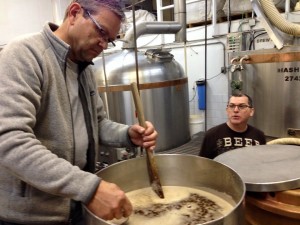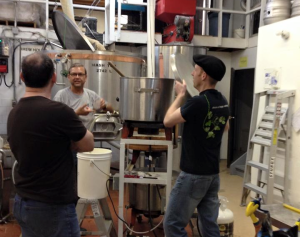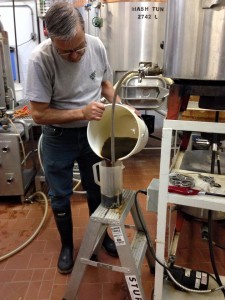
Neil Herbst stirs the mash while brewing Girder Bender Historical Stout while your humble author looks on.
As I mentioned here, last month the Edmonton Heritage Council hosted a beer history tour of Edmonton. One of the cooler aspects of the tour was an heritage beer made exclusively for the tour. The organizers rather cheekily dubbed the beer Girder Bender to link it to the epic 102 Ave bridge fail of 2015.
At the time I offered a few details about the beer and promised to tell more about it another day. I guess that day is today. So come backstage with me and experience the inside story of the creation of Girder Bender. It is a tale of BBQs on fire, popcorn poppers, missed targets and, in the end, a pretty decent beer.
The process started in the office of Alley Kat’s Neil Herbst. Neil and I examined a book of historic beer ads in early 20th century Alberta. We noticed most breweries, in addition to “beer”, which we assumed to be their lagers, sold porter or stout. The idea of a stout seemed to fit the bill well. I went off to research old recipes. I focused on late 1800s England, estimating that early 1900s brewers in Alberta would be working with similar recipes. Rather than go with one recipe, I crafted a malt bill that reflected the general approach. We went with a bill of 80% pale malt, 13% brown malt and 7% black malt.
Interestingly, stout malt bills were very simple until the 19-teens, when they became noticeably more complex – paralleling the shift from brewery-based malting and kilning to professional maltsters. We thought the simpler approach would produce a more authentic version.
I made some rough hop addition calculations from the historical recipes – which wasn’t easy since they didn’t report alphas or much else for that matter. My initial calculation of 2.75 pounds per gallon turned out to be seriously over-hopping. Neil calculated using 5% alpha Goldings (which is what we were using) it would have 220 IBUs! We figured that alpha levels and kettle utilization were much lower then. We scaled back to a more reasonable 100 grams for our 50-litre batch.
The initial idea was to home roast the brown and black malt. I took on the black malt and Neil volunteered to try making the brown malt. I did some reading to work up how to best do it at home. Oven roasting seemed possible, but the warnings of excessive smoke scared me off that approach. However, I read doing it on the BBQ with indirect heat can work, so I gave that a try.
Hmm. Not so much. I couldn’t keep the heat consistent and ended up scorching half while leaving half untouched. It even caught fire at one point. I moved on to Plan B. A friend has a Big Green Egg, a fancy ceramic BBQ known for their finessed temperature control, and he offered it up. So I walked over to his house and we set about egging the malt. Three hours later it had only turned a middling brown, not even close to black malt. I reluctantly called the experiment a failure and informed Neil we would need to use commercial black malt.
While I was busy setting my BBQ on fire, Neil was trying to use a hot air popcorn popper to make his brown malt. He made only half of his intended volume because it took too long and he lost patience. On brew day we compared my Green Egg malt and his brown malt to a bag of commercial brown malt. We declared my batch, while slightly uneven and with a slight smoky character, was not a bad representation of brown malt. So in the mash it went, along with commercial pale and black malt.
Brew day started fairly smoothly. Alley Kat’s pilot system is not unlike my home set-up and so it was an easy transition. Plus it is pretty sweet to have 5000 litres of hot water just sitting waiting for you. Shane Groendahl from the Beer Geeks Anonymous pitched in for part of the day, and Monica from the Heritage Council popped by to take photos (for historical archival purposes, of course).
But the mis-adventures were not over. We used whole leaf hops grown near Wabamum and they completely plugged the hoses during transfer (we blame one of Neil’s brewers for talking us out of a hop bag), necessitating a messy hand transfer. We somehow missed our target gravity, even after boiling for 30 minutes longer than planned. I wonder if my homemade brown malt didn’t convert.
We also forgot to take a post-boil gravity reading (likely due to our hop mess), although Neil was able to reverse engineer that in his lab.
On the whole a standard homebrew-like brew day.
The beer itself turned out better than I expected. While it lacked the rounded dimensions a modern-day stout would have, it had a pleasant roastiness and enough heft in the body to make it a filling beer. The roast wasn’t coffee-like but more grainy (a result of the missing roasted barley, I suspect). I detected a touch of smokiness coming through in the flavour as well, but that may just be my hopeful imagination.
Girder Bender was a hit among the 80 or so attendees of the Beer History Tour and for our trouble, Neil and I split the leftovers after the event. The last litres of it still sit in a keg in my beer fridge – so if you are real nice to me…



May 21, 2015 at 7:23 PM
I was lucky enough to be in the tour and got to sample some Girder Bender… unique and very quaffable! Too bad Neil doesn’t do a run of it.
May 22, 2015 at 3:03 PM
If my childhood in the garage is any guide, knowing when to stay out of the way is hard and important work!
May 25, 2015 at 9:01 PM
Great story behind this brew. I had no idea they were growing hops in Wabamun!